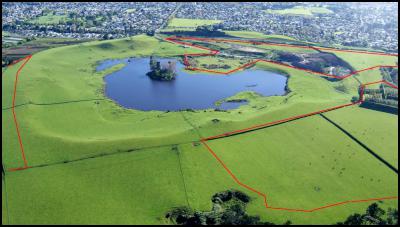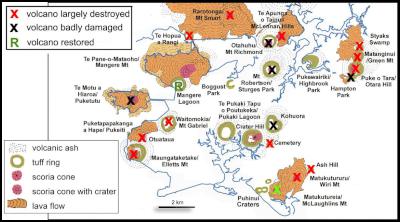Proposed world heritage volcano to be built over
Proposed world heritage volcano to be built over
Auckland's irreplaceable volcanic heritage to be sacrificed for more houses
Crater Hill tuff cone is clearly visible out the window of your plane as you take off or land at Mangere airport.

If the Independent Hearings Panel recommendations on the Unitary Plan are adopted by the Council, one of Auckland's most valued volcanoes, Crater Hill in Papatoetoe, will be partly built over with a large area of mixed housing right inside the amazing crater itself. Crater Hill was recently ranked eighth most-valued volcano in a report to the Ministry of Culture and Heritage assessing the case for a proposed nomination of the Auckland Volcanic Landscape as a World Heritage property potentially containing up to 21 separate volcanoes. The higher ranked volcanoes are Rangitoto, Motukorea, Mangere Mt, Maungakiekie, Maungawhau, Maungarei, and Otuataua stonefields.
Crater Hill is the last remaining privately-owned volcano in the Auckland volcanic field. Its high heritage values and undeveloped open space have been recognised and protected for over 30 years through zoning and scheduling as an outstanding natural feature in the Manukau District Scheme and Auckland Regional Policy statement and it has been ranked as a volcano of national importance in a New Zealand-wide register since 1992. Over the years there have been numerous hearings and negotiations with the long-time owner in attempts to secure its protection through purchase by local and regional councils. Throughout this period the owner has exercised an historic quarrying licence to nibble away at one side of the crater and remove a small scoria cone. In recent years quarrying has stopped and most of the excavation has been backfilled so that only a little recontouring would be needed to restore the damaged east side of the crater. The recommended version of the Unitary Plan has policy “D10.3(7) Encourage the restoration and enhancement of outstanding natural features.”

The recommendation by the Hearings Panel, like many they have made, is quite contrary to what was advertised in the proposed Unitary Plan by Auckland Council, and has come about because of the government drive to open up more land for housing. The advertised Unitary Plan placed Crater Hill outside the Urban Boundary and proposed continuing the existing Rural Zoning and Outstanding Natural Feature scheduling for the whole volcano. The Hearings Panel proposes to retain the outstanding natural feature scheduling but divides the volcano into single and mixed residential housing, coastal transition and open space zones. The residential zone covers most of the outer slopes of the tuff volcano with the denser mixed housing zone filling the part of the crater damaged by the owner's quarrying activities. The crater lake is already in council ownership and most of the rest of the inside of the crater is proposed to be open space.
The panel has decided to accept in its entirety, without notification and therefore informed discussion and hearings, the owner's proposal to inflict still further damage on our city's volcanic heritage. In doing this the panel has ignored decades of documentation of the heritage values of this feature and thumbed its nose at the Auckland Council's own evidence that strongly advocated for keeping the volcano intact. To justify the proposed intrusion of housing into the crater, right down to the lake edge, the owner argues that only areas he has already damaged will be affected and ignores the potential for restoration.
A 2013 assessment of the heritage values of Crater Hill commissioned by Auckland Council rated the volcano as a whole as of national importance because of its rare and outstanding features. These included the essentially unmodified semi-circular crest and gentle outer slopes of the tuff cone (the only cone like this left in Auckland), and the best preserved example in New Zealand of a lava lake that had drained back down the vent.
Although Auckland has lost many of its volcanoes to quarrying and urban expansion, the remains of many are now preserved as cherished green oases on the North Shore and isthmus. In south Auckland however far more has been lost, with 65% of volcanoes destroyed (12) or badly damaged (5). At present Crater Hill is the second best preserved of the remaining southern volcanoes, after Mangere Mt.
Maybe we can forgive our forebears for the early damage to our volcanoes. In the latter half of the twentieth century Aucklanders became more aware of the amazing volcanic treasures we had left in our “City of Volcanoes”. In the 1990s-2000s Auckland citizens (Auckland Volcanic Cones Society) mobilised and successfully opposed further proposed damage from motorways, subdivisions and prisons to parts of Mt Roskill, Te Hopua, Mt St John, Mt Wellington and McLaughlins Mt. Now, well into the twenty-first century, one would have thought that what is now proposed for Auckland's last remaining privately-owned volcano would have been impossible. Welcome to the new world of more housing subdivisions, no matter what the cost.
Bruce Hayward is a geological heritage expert, former member of NZ Conservation Authority and author of the book,Volcanoes of Auckland - the essential guide.
ends


 Gordon Campbell: On unemployment, Winston Peters’ low boiling point and music criticism
Gordon Campbell: On unemployment, Winston Peters’ low boiling point and music criticism Labour Party: National Gaslights Women Fighting For Equal Pay
Labour Party: National Gaslights Women Fighting For Equal Pay The Treasury: New Treasury Paper On The Productivity Slowdown
The Treasury: New Treasury Paper On The Productivity Slowdown NZ Government: Government Recommits To Equal Pay
NZ Government: Government Recommits To Equal Pay Emily Ireland - Local Democracy Reporter: Deputy Mayor ‘disgusted’ By Response To Georgina Beyer Sculpture
Emily Ireland - Local Democracy Reporter: Deputy Mayor ‘disgusted’ By Response To Georgina Beyer Sculpture Te Pāti Māori: Māori Unemployment Rate Increases By More Than Four-Times National Rates
Te Pāti Māori: Māori Unemployment Rate Increases By More Than Four-Times National Rates Government: Streamlining Building Consent Changes
Government: Streamlining Building Consent Changes


